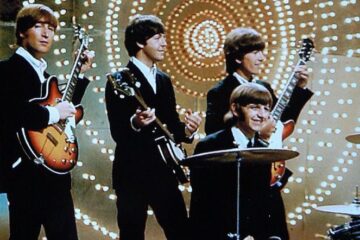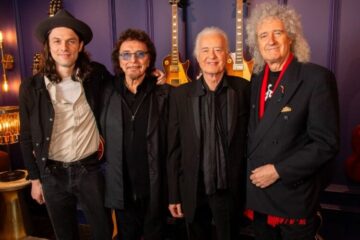Please use the sharing tools found via the share button at the top or side of articles. Copying articles to share with others is a breach of FT.com T&Cs and Copyright Policy. Email licensing@ft.com to buy additional rights. Subscribers may share up to 10 or 20 articles per month using the gift article service. More information can be found at https://www.ft.com/tour.
https://www.ft.com/content/e479d39d-be2e-4ade-95b8-1cd68bab7814
“It is the most sought-after recording console, from the most famous studio in the world, used by the greatest band in history, to make probably their most famous record.” Listening to British record producer Mike Hedges describe his precious asset as he prepares to offer it for sale, one might suspect him of a little marketeering. But in the case of the TG 12345 Mark 1 studio mixing desk, which comes to auction at Bonhams in London on Thursday December 14, there is little hyperbole at play.
Known as the “Abbey Road” console, this is the desk on which The Beatles worked for the final time in the studio together, in 1969. Gathered around it in Studio 2 of EMI’s London premises on Abbey Road, they were reunited with producer George Martin to record the last album they recorded together, ultimately named Abbey Road after what had become their creative home. The album has been cited by many, including Martin himself, as the pinnacle of their creative achievement.
Please use the sharing tools found via the share button at the top or side of articles. Copying articles to share with others is a breach of FT.com T&Cs and Copyright Policy. Email licensing@ft.com to buy additional rights. Subscribers may share up to 10 or 20 articles per month using the gift article service. More information can be found at https://www.ft.com/tour.
https://www.ft.com/content/e479d39d-be2e-4ade-95b8-1cd68bab7814
On its release in September 1969 it went straight to number one, and repeated the feat when it was re-released in 2019. Its total sales exceed 19mn copies, while its cover photo of the four Scousers on the zebra crossing outside Abbey Road is one of the most recognisable images of the 20th century. In the light of the album’s commercial success and cultural cachet, the then EMI Studios was renamed Abbey Road Studios. It is still a brand name that carries unmatched prestige in the recording industry.
At the auction on Thursday, the Bonhams estimate is “a seven-figure sum”. Yet for all the sublime creativity it once inspired, visitors to the public preview of the desk in the past week would have found an unprepossessing object of utilitarian appearance. Its colour scheme, predominantly slate or battleship grey, belongs more in the control tower of a cold-war air base than a hotbed of rock-and-roll outpouring. Only the row of radial quadrant faders — raised and curved to fit a cupped palm, and known as Paintons — bring to it a touch of warmth.
Please use the sharing tools found via the share button at the top or side of articles. Copying articles to share with others is a breach of FT.com T&Cs and Copyright Policy. Email licensing@ft.com to buy additional rights. Subscribers may share up to 10 or 20 articles per month using the gift article service. More information can be found at https://www.ft.com/tour.
https://www.ft.com/content/e479d39d-be2e-4ade-95b8-1cd68bab7814
“When they designed the desk at EMI, the most reliable parts they could get — switches, resistors — were military specification,” says Hedges. “So it is super precise and accurate to use. That is why I have been collecting TGs all my life.” The EMI engineer who designed the Mark 1 desk, Mike Bachelor, is often described as the godfather of the modern mixing console. His prototype boasted 24 microphone inputs and eight output channels (The Beatles’ Sergeant Pepper album, by contrast, had four output channels), with the ability for the first time ever to modulate the sound of each one individually. It was initially installed in Room 65 at Abbey Road, the experimental room, but in the summer of 1968, the desk was moved into Studio 2 for use by recording artists. Then the magic began.
It was the interplay between formality and licence that made The Beatles’ relationship with Abbey Road so fruitful and so fascinating. In images from the era, the EMI staff hierarchy — a crisp white shirt and tie for the brass, know-your-place brown overalls for others — contrasts vividly with the scruffy flamboyance of the musicians. And when the studio door closes and the making of Abbey Road begins, it is the irreverence of The Beatles that permits the technicians to break the rules and test the creative possibilities of their new toy.
Please use the sharing tools found via the share button at the top or side of articles. Copying articles to share with others is a breach of FT.com T&Cs and Copyright Policy. Email licensing@ft.com to buy additional rights. Subscribers may share up to 10 or 20 articles per month using the gift article service. More information can be found at https://www.ft.com/tour.
https://www.ft.com/content/e479d39d-be2e-4ade-95b8-1cd68bab7814
The band’s biographer Hunter Davies recalls this as a time of exceptional focus for the Beatles. “They knuckled down to work,” he says in an essay to accompany the sale. “The atmosphere was good. Perhaps because they knew it was the end. By the time they got to the second side of the album, they were determined to get in as many new songs as possible, even those half-finished.” The TG brought exceptional depth of character to their compositions. “Here Comes the Sun”, “Something”, “Come Together” sounded markedly different to their earlier work — fuller, richer, deeper.
Please use the sharing tools found via the share button at the top or side of articles. Copying articles to share with others is a breach of FT.com T&Cs and Copyright Policy. Email licensing@ft.com to buy additional rights. Subscribers may share up to 10 or 20 articles per month using the gift article service. More information can be found at https://www.ft.com/tour.
https://www.ft.com/content/e479d39d-be2e-4ade-95b8-1cd68bab7814
The desk was removed from service at Abbey Road in 1971 to make way for a new Mark II version, and parts of it were donated to a school. These eventually ended up in a skip, where they were discovered by a tape-machine maintenance engineer. “I bought the bulk of the desk in 1992 and started putting it together like a jigsaw puzzle,” says Hedges. “Five years ago I realised I had all the bits.” With the help of former Abbey Road engineers, Hedges has reunited its disparate elements, along with spares from Abbey Road and EMI’s archives in Hayes, west London, and replaced certain others. The result is a fully operational Mark 1 comprising around 70 per cent of the original parts.
Please use the sharing tools found via the share button at the top or side of articles. Copying articles to share with others is a breach of FT.com T&Cs and Copyright Policy. Email licensing@ft.com to buy additional rights. Subscribers may share up to 10 or 20 articles per month using the gift article service. More information can be found at https://www.ft.com/tour.
https://www.ft.com/content/e479d39d-be2e-4ade-95b8-1cd68bab7814
After a stint as an engineer at Abbey Road in the early 1980s, Hedges first found success as a producer in the early 1980s for acts such as The Cure, Siouxsie and the Banshees and Marc Almond. His love of the TG console has led him to invest in four different iterations, Marks I through IV, all acquired from his former employer. The Mark IV was the console on which Pink Floyd recorded Dark Side of the Moon; in 2017 Hedges sold this desk, also at auction. On an estimate of $700,000 it went to an unnamed bidder for $1.8mn.
So what is it that makes a TG desk so special, that imparted such a distinctive and desirable timbre to these recordings? “It’s the transparency,” he says. “The sounds are very three-dimensional. Modern consoles, being digital, should sound fantastic, but for some reason the old analogue consoles alter the sound slightly. They do something to it. The music sounds bigger, wider, clearer.”
But it was surely more than just audio quality that persuaded someone to find $1.8mn for the Pink Floyd desk, and is likely to do something similar for the Abbey Road machine. Vintage music equipment is imbued with a mystic, almost magical, quality — a sense of the ghost in the machine. Does Hedges believe that the desk contains the spirit of Abbey Road? He laughs. “People do treat it like a sacred object,” he says. “And it may sound crazy but the electrons from when The Beatles used the console are still in it. They move around, from one end to the other.”
After Abbey Road, the console was used for some orchestral sessions, and on projects by Paul McCartney, John Lennon and Yoko Ono, and Ringo Starr, before being dismantled in 1971. What is on sale is its illustrious past — a prized artefact from music history — but also the future: a limitless world of music that it may yet make.




